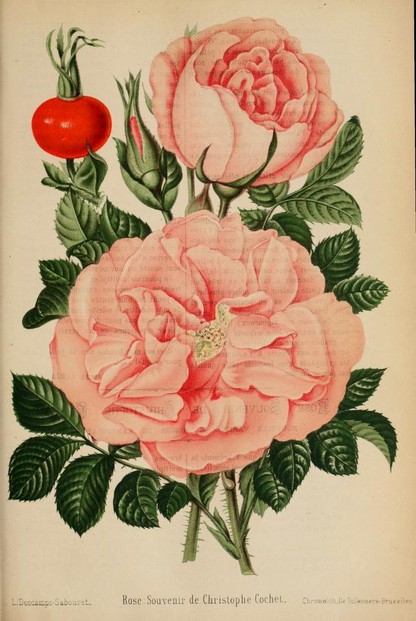Beales, Peter. Passion for Roses: Peter Beales' Comprehensive Guide to Landscaping with Roses. New York: Rizzoli, 2004.
Brenner, Douglas, and Stephen Scanniello. A Rose by Any Name . Chapel Hill NC: Algonquin Books, 2009.
"Les Cochets et le Journal des Roses." Archives Départementales de Seine-et-Marne > Culture & loisirs > Galerie des trésors. 2013. Conseil général de Seine-et-Marne. Web. archives.seine-et-marne.fr
- Available at: http://archives.seine-et-marne.fr/le-journal-des-roses
Darlington, H.R., and Rev. J.H. Pemberton. “The Progress and Development of the Rose During Those One Hundred Years of Peace.” Journal of the International Garden Club, Vol. I. No. 1 (August 1917): 243-255.
- Available via Internet Archive at: http://archive.org/details/journal11917inte
“Fragrant Roses.” Growing Roses. All-America Rose Selections. www.rose.org
- Available at: http://www.rose.org/fragrant-roses/
Gravereaux, Jules. La Malmaison: Les roses de l'impératrice Joséphine. Préface de Frédéric Masson de l'Académie Française. Paris: Éditions d'art et de littérature, c1912.
- Available via HathiTrust at: http://catalog.hathitrust.org/Record/002010619
Gravereaux, Jules. "La Roseraie de L'Haÿ." Pages 21-29. In: Edward Mawley, ed., The National Rose Society's Rose Annual for 1914. Croydon: Jesse W. Ward, 1914.
- Available via HathiTrust at: http://hdl.handle.net/2027/mdp.39015065427794
Gravereaux, Jules. Les Roses cultivées à l'Haÿ en 1902: essai de classement. Avant-propos de André Theuriet. Aquarelles et dessign de S. Hugard. Paris: Jules Rousset, 1902.
- Available via Internet Archive at: https://archive.org/details/lesrosescultiv00rose
Gravereaux, Jules. “Rapport sur la Culture des Roses dans la Péninsule des Balkans.” Journal des Roses, Tome XXV (1er août 1901): 117-120.
"Jules Gravereaux, son oeuvre." Le jardin: Histoire. La Roseraie du Val-de-Marne. Conseil général du Val-de-Marne.
- Available at: http://www.roseraieduvaldemarne.fr/roseraie_internet_2010/spip.php?page=rose_roseraie_rubrique&id_rubrique=213&lang=fr
Kazanlik.” Rose of the month. June 2008. Roseraie du Val-de-Marne. www.roseraieduvaldemarne.fr
- Available at: http://www.roseraieduvaldemarne.fr/roseraie_internet_2010/spip.php?page=rosedumois&id_rubrique=183&id_article=708&lang=en&annee=2008
Leboeuf, l'Abbé Jean. Histoire de la Ville et de Tout le Diocèse de Paris. Tome cinquième. Paris: Librairie de Féchoz et Letouzey, 1883.
Le Queux, William. An Observer in the Near East. Illustrated by the Author and Princess Xenia of Montenegro. London: T. Fisher Unwin, 1907.
- Available via Internet Archive at: http://archive.org/details/observerinnearea00lequrich
- Available via Project Gutenberg at: https://www.gutenberg.org/files/65766/65766-h/65766-h.htm
Mich, K. “Louis-Antoine Comte de Bougainville (1729-1811).” Liens utiles > Qui est Bougainville? Lycée Agricole Bougainville. www.lycee-bougainville.fr
- Available at: http://www.lycee-bougainville.fr/wp-content/uploads/2011/01/LouisdeBougainville.pdf
Modern Roses XI: The World Encyclopedia of Roses. San Diego: Academic Press, 2000.
"Pierre Christophe Cochet (1777-1819)." Célébrités. Société d'Histoire, d'Art, de Généologie et d'Échange. www.genea77-shage.info.
- Available at: http://www.genea77-shage.info/sommaire/celebrites/celebrites/cochet.htm
Quest-Ritson, Charles and Brigid. American Rose Society Encyclopedia of Roses. 1st American Edition. New York: Dorling Kindersley, 2003.
"Rose Souvenir de Christophe Cochet: Nouvelle Variété du Rosier de Kamschatka." Journal des Roses (Rosa Inter Flores). Dix-Huitième Année. Année 1894 (septembre 1894): 136-137.
- Available via Biodiversity Heritage Library at: https://www.biodiversitylibrary.org/page/9558905
- Available via Internet Archive at: https://archive.org/details/journaldesroses1820pari
“La Roseraie de L'Haÿ.” The ‘Luciae’ or ‘Wichuriana’ Rambler Roses. John S. Harrison and Mark Parkinson. www.harislau.co.uk
- Available at: http://www.harislau.co.uk/roseraiedelhay.htm
Société Nationale d'Horticulture de France. Section des Roses. Les Plus Belles Roses Au Début Du XXe Siècle. Ouvrage honoré du prix Joubert De L'Hiberderie. Paris: Charles Amat, 1912.
“Swiss Pro Juventute Set Due November 28.” Tell: Voice of the American Helvetia Philatelic Society, Vol. 3, No. 10 (November 1977): 223.













!["Testing Otto [Attar] of Rose at Kazanlik"; William Le Queux-An Observer (1907), Chapter V, opp. page 224 "Testing Otto [Attar] of Rose at Kazanlik"; William Le Queux-An Observer (1907), Chapter V, opp. page 224](/static/uploads/en/module/image/2013/10/29/2013-10-29_14-32-35_458.622x621.jpg)









 Are Hawaiian Huakai Po Nightmarchers Avenging Halloween Thursday?on 10/02/2024
Are Hawaiian Huakai Po Nightmarchers Avenging Halloween Thursday?on 10/02/2024
 Mailing Addresses for 2023 Form 4868 Extending 1040 and 1040SR April 15, 2024, Due Dateon 04/15/2024
Mailing Addresses for 2023 Form 4868 Extending 1040 and 1040SR April 15, 2024, Due Dateon 04/15/2024
 Mailing Addresses for 2023 Forms 1040 and 1040SR Filed in 2024on 04/15/2024
Mailing Addresses for 2023 Forms 1040 and 1040SR Filed in 2024on 04/15/2024
 Mailing Addresses for 2022 Form 4868 Extending 1040 and 1040SR April 18, 2023, Due Dateon 04/13/2023
Mailing Addresses for 2022 Form 4868 Extending 1040 and 1040SR April 18, 2023, Due Dateon 04/13/2023



Comments
cmoneyspinner, Yes, all of your descriptors apply to roses! What's amazing about roses is how alike they are and how subtly different they are, but all are beautiful and fragrant.
Thank you for pinning! These two roses have a special place in my heart.
Stunning! No. Gorgeous! No. Beautiful! No. Lovely! All of this and more! I always loved roses. There are so many varieties. Like orchids. So like ... no matter what kind of rose, do they all have thorns? No matter. I'll love them just the same. Thorns and all! Pinning.